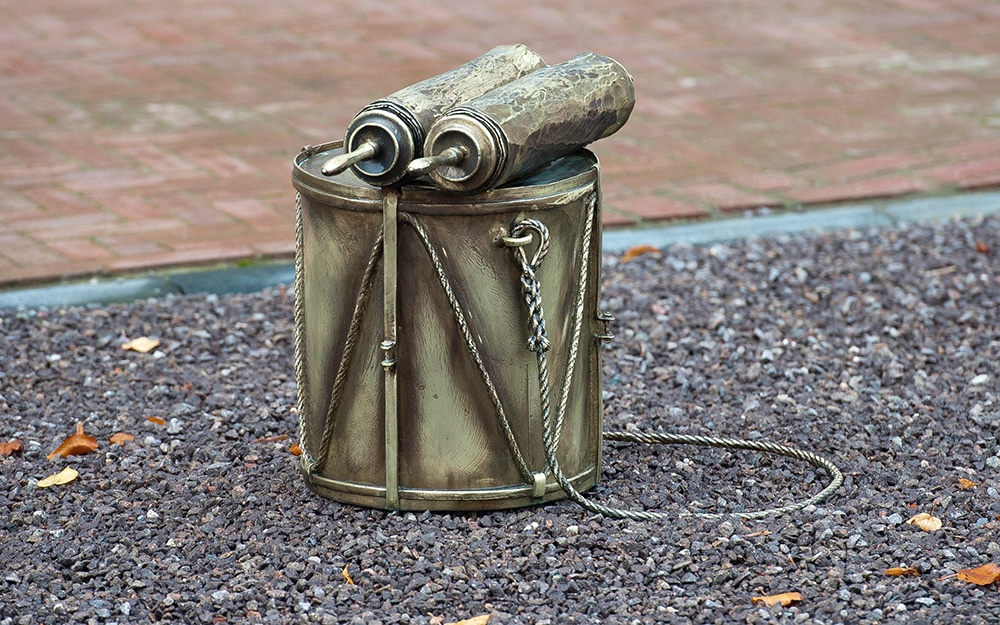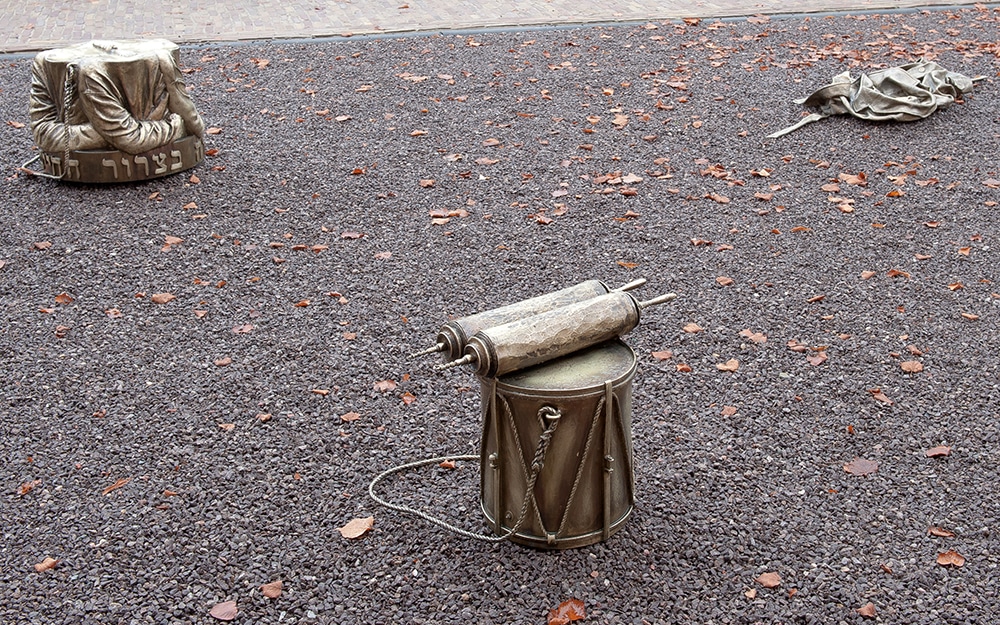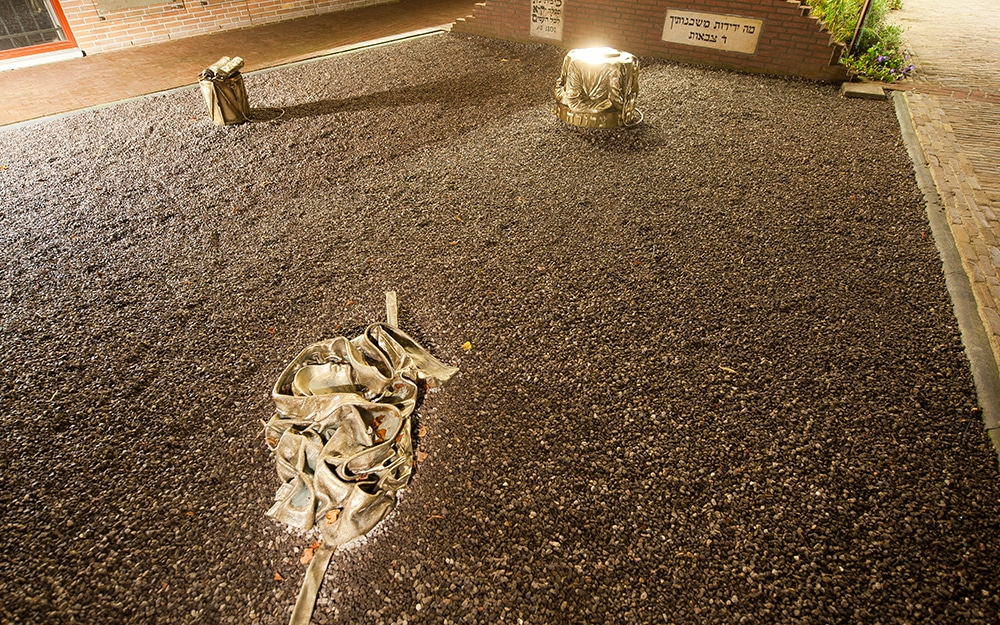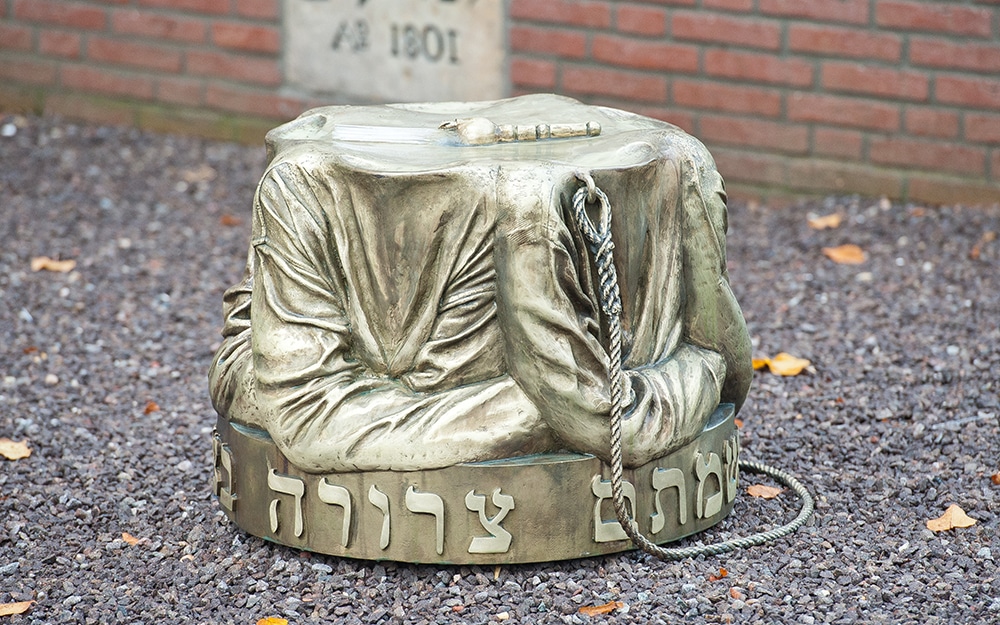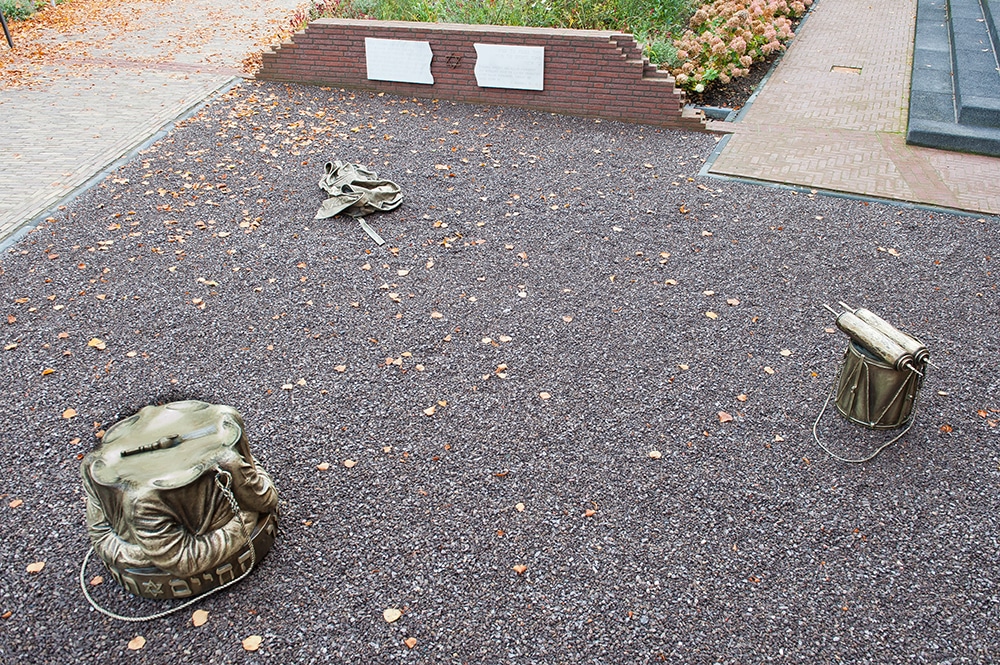Covenant of Joy and Sorrow
Covenant of Joy and Sorrow (2015)
Bronze, LED lights, plexiglass staff.
Large drum with light carrier 80 by 80 cm
Small drum with Torah scroll 50 by 50 cm
Overcoat 100 by 70 cm
This text was taken from a speech by Famke van Wijk during the opening of the Memorial Garden in Oldenzaal September 10th 2015. In memory of the Jewish families from Oldenzaal who were killed in the period 1940-1945. The official opening was performed by Chief Rabbi Binyomin Jacobs.
These images were created in memory of the Jewish population of Oldenzaal and all the Jewish victims of the persecution of Jews in WW2. The key words for this task were; Imagination – Experience – Identity – Meeting spot – Lodging- Awareness – History and Tolerance. My desire and hope went out to the revival of an ancient Jewish prayer, that when we enter the Memorial Garden we will feel a little bit closer to our loved ones, but also a little bit closer to the pain and unspeakable suffering of the Jewish people which is what we want to provide a place for here.
The suffering was to get a place, a place of awareness, a place where the history of the past can regain perception and awareness.
A place where there is room for imagination and tolerance, a place where we can remember and want to reside.
This prayer have I applied to the lower edge of the largest drum in the Hebrew language (clearly visible) which means: “May their souls be bundled into the covenant of eternal life.” Which meaning I wanted to represent with the torsos interlocking with each other. This text is still being used as a prayer for both the living and the dead. And is also used for tomb and memorial stones.
Faith can give us courage and willpower to survive, but also joy that we need in tough times. I have highlighted these attributes of faith, which also signifies the faith and the identity of the Jewish people, by using the Torah, the drums and the “Jad.”
Jad is a fescue, which is used to read the Torah, the holy book of the Jews. When reading, the text is followed by the stick so that the scroll, the sacred book, is not touched directly and is therefore protected symbolically. The Jad literally has a small hand at the top of the stick with an outstretched forefinger to follow along with the text. I have given the pointing – stick another function by letting the hand point to the light that now shines out of the scroll, as a reference to our heavenly home and our “togetherness” with God. The dead are reunited in the light and the “love of God.” And brings hope and comfort, which is so badly needed.
The Synagogue in Oldenzaal combined the look of beauty with the security of a shelter. Where worship, which by definition, occurs through the sanctification of words.
Through the attentive and respectful reading of the words of the Torah, in this way they are kept in the heart of man. The Torah scrolls have I used to symbolize the love of life, and the love of God.
According to the “Nefesh,” the traditional Jewish view of the soul, there is no difference between the spiritual and the physical.
According to Jewish belief, the soul is a part of the physical and spiritual world of man.
The Jad and the large drum, I also wanted to give a physical and a spiritual resemblance. The Jad also resembles a brush. This is used on drums to create a soft rustling sound. This refers to music which is a great source of inspiration in the Jewish tradition. I was inspired by a beautiful old Jewish saying: “Everyone is an instrument and everyone’s life is the melody.” Also to represent the source of joy, the will to survive, and the source of love. The images provide inspiration.
Every day is spiritually but also physically worn in an ancient belief that joy and suffering (sorrow) come together and get their experience in the rich Jewish traditions and culture.
For example, during a Jewish wedding, under the “chuppah” the seven blessings are pronounced, the ‘Sjeva berachot’, but at every party ‘Simcha’ sorrow should also be represented. So the groom stomps with his foot and shatters a glass under the “chuppah.” Which symbolizes the destruction of the Holy Temple
The temple, their higher purpose in life, their desire to be with God, has been put on the first place, and currently sacredly commemorated again. It has eternal beauty if joy and sorrow come together.
There is music, the crowd goes crazy… there is joy!! Mazel Tov!! One wishes to each other.
The Klezmer musicians start loudy with their cheerful clarinet, their cimbalom, quick-fingered violin, and drum.
Everyone dances, even if he cannot do it well, the rabbi begins dancing and dances with fire in his eyes… everyone is an instrument and everyone’s life is the melody.”
At the Jewish wedding, with a lot of joy sorrow is also remembered.
But how do you remember the source of joy, the will to survive, the source of love, beside so much persecution and suffering? Can joy of a Faith (which ever Faith it may be) enlighten us above the temporal and earthly, with all its hardships and pain?
May the joy of a faith help process untold suffering?
It is truly a celebration if faith can bring comfort, joy and even vitality.
This is what I wanted to portray with the large and small drums. The drums themselves stands for joy and gladness, but the larger drum has a double meaning; You see that there are literally and figuratively people interconnected with each other… connected by their covenants in joy and sorrow. And they bear one another’s burdens and pain, but they also share in each other’s joy, namely the love of God. They also bear the name ” The covenant people.”
In all their struggles as a people to survive, Zion is no longer a poetic metaphor, but an obligation, a destination.
My heart is in the east, and I in the uttermost west How can I find savour in food? How shall it be sweet to me?
How shall I render my vows and my bonds, while yet Zion lieth beneath the fetter of Edom, and I in Arab chains?
A light thing would it seem to me to leave all the good things of Spain —
Seeing how precious in mine eyes to behold the dust of the desolate sanctuary.
Yehuda Halevi.
The unspeakable suffering that has been inflicted to the Jewish people is depicted by the coat.
They literally had to leave their lives behind, had to lay down … as if you take your clothes off and leave them behind, not knowing that they would not receive water, but the gas. This disgrace, this loss, and pain must still be worn to remember never be forgotten. They had to bear grief, where we can still not be fully aware of. That’s why I concealed the silhouette of a face in the lining of the jacket.
Through the Torah, and other symbolic sacred texts and scriptures, but I also think of the many symbolic objects such as for example: The “Menorah ” and their great faith in God, Judaism could always survive and retain its cultural, intellectual and spiritual identity.
In this monument, I wanted to emphasize the contrast between joy and pain, which may be simultaneously present in a philosophy of life, which go together in love and power.
The title of this Monument is: “Covenant of joy and sorrow.”
Famke van Wijk

